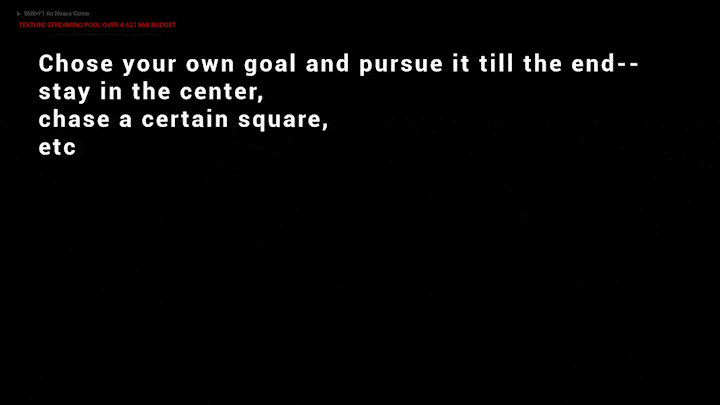Structure-Centric Emergent Narrative Prototype
Solo Project
Introduction
A structured Emergent Narrative where the player is the protagonist, who decides their own goal. The game then predicts that goal, and antagonizes the player in accordance with structure.
Developed over 5 months
Solo
Project Details:
-
Created an abstract procedural narrative generator, based on three act structure
-
Developed system that detects the player’s goal, then tells AI assets to conflict with that goal, in increasing difficulty, until the player receives a power-up in the climax
Goal
Create a prototype which successfully elicits the feeling of living a story.

Pre-production
Research
Per my university’s requirement, I wrote a research paper outlining my concept behind this project after reading related game studies literature.






Organization
Despite working alone, I made a Gantt chart to keep track of my progress, adding some stretch goals to give myself room in case anything went wrong when programming.
Scope
While my original vision was to make as many playable goals as the player could hypothetically think of within the state space, I decided to scope down to the three most obvious goals: stay in the center, reach the edge, and chase a square.




Design Process
Plan
I wrote a basic outline for one of the playable goals to help me decide the AI behavior I needed to code for the player and what assets I needed to create



Behavior
I used UE’s built in AI behavior tree to utilize its behavior tree, which manages all the NPCs.




Apotheosis
In addition to the NPCs, the Player is affected by structure. Just before the climax with a power—Apotheosis. After the game’s difficulty scale has reached its peak, the player gets a power-up suited best to their route: faster speed when reaching the edge, pushing the NPCs back further when trying to stay in the center.

Set Up
After setting up the basic physics for the player NPCs to bounce off each other, I developed a system of timers and post-processing effects to suit each act and plot point. The breaking point comes just before Act III, and it’s the section where things seem their most hopeless, so I made its effect dark red.



Triggering Behaviors
The basic NPC has a state machine that is triggered by the different plot points and player behavior, which decides which tags to send to the NPCs.



Stay In Center Route Walkthrough

Act I, part 1
In the beginning of the game, the player is introduced to their options in an intro text before they start. Then other squares move about randomly, allowing the player to choose their goal.

Act I, part 2
In the beginning of the game, the player is introduced to their options in an intro text before they start. Then other squares move about randomly, allowing the player to choose their goal.

Act II, part 1
If the player chooses to stay in the center, in act 2, the other squares start pushing the player away form the center.

Act II, part 2
At the midpoint, all NPCs start pushing the player. And just before act 2 ends, there's a breaking point, the start attacking more frequently.

Act III, part 1
Now that the difficulty is at its peak, the player is granted apotheosis. They can push the NPCs back much further, helping them keep in the center.

Act III, part 2
At the dénouement, the other squares give up, and the player is awarded a moment of victory. However, if the player ever loses their goal (being forced out of the center) they are pushed away to the end--fade to black.
Closing Thoughts
A lot of sacrifices had to be made to keep this in scope for the time I had.
Emergence — The original idea was to have the player's response to conflict determine which types of conflict should be used in the next phase; if the player is too fast, make the NPCs faster. However, this prototype functions more like a traditional branching narrative, the only emergent elements are the moment-to-moment actions along the route.
Difficulty Scale — There's also only one difficulty scale. If I were to work on this in the future, I would make the player have an unseen score that determines the level of conflict in each act.